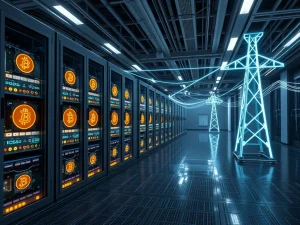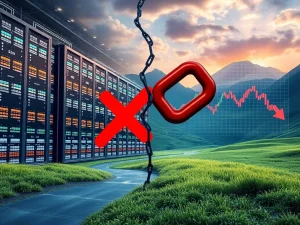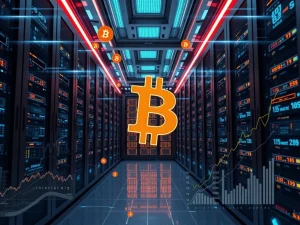Bitcoin Mining: Brazil’s Thopen Pioneers Brilliant Solution for Surplus Solar Power

The global energy sector faces a profound transformation. Renewable sources are surging, creating both immense opportunity and unique challenges. Now, a fascinating synergy emerges: Bitcoin mining leveraging excess green power. This innovative approach could redefine energy monetization. Brazilian solar firm Thopen stands at the forefront of this movement. They are actively exploring Bitcoin mining to absorb surplus renewable electricity. This strategy addresses a critical issue for modern energy grids, particularly in rapidly expanding renewable markets.
Thopen’s Strategic Pivot: Monetizing Surplus Solar Power with Bitcoin Mining
Thopen Bitcoin is signaling a significant shift in its business model. Gustavo Ribeiro, CEO of Thopen and its majority owner, Pontal Energy, recently detailed these plans. He shared insights with local outlet BN Americas. The company seeks to diversify its operations. This diversification aims to mitigate Brazil’s energy oversupply. Ribeiro explicitly mentioned considering data centers. He also highlighted Bitcoin mining as a solution. These operations would be located “near the load.” This proximity ensures efficient absorption of locally generated energy. Such a move directly addresses the challenge of renewable energy curtailment. It transforms a potential loss into a profitable venture. Thopen’s exploration reflects a growing trend. Energy producers are seeking innovative ways to maximize asset utility. This proactive step positions Thopen at the intersection of sustainable energy and digital finance.
Brazil’s Renewable Energy Boom and the Challenge of Energy Oversupply
Brazil renewable energy production has expanded dramatically in recent years. The nation boasts abundant natural resources. These include vast solar and wind potential. This rapid growth has positioned Brazil as a leader in green energy. However, this success brings a complex problem: energy oversupply. An August Reuters report highlighted this national issue. The government is actively seeking solutions. They plan bidding rounds for more stable power sources. These include hydroelectric and fossil-fuel thermal plants. This strategy aims to balance the grid. It also reduces reliance on intermittent sources like wind and solar.
Solar power Brazil facilities are particularly affected. They frequently experience curtailment. Curtailment means limiting the amount of energy they can supply. This occurs when generation exceeds grid demand or transmission capacity. Ribeiro described curtailment as “a challenge for the sector.” It represents lost revenue for energy producers. The diagram from OurWorldInData clearly illustrates Brazil’s increasing renewable energy percentage. This trend underscores the urgency for effective oversupply solutions. Thopen’s initiative offers a compelling path forward.
Bitcoin Mining: A Dynamic Solution for Intermittent Power
The inherent flexibility of Bitcoin mining makes it an ideal partner for renewable energy. Mining operations can quickly scale up or down. This adaptability allows them to consume surplus power efficiently. When Brazil’s energy oversupply occurs, miners can increase their hash rate. This absorbs excess electricity. When grid demand is high, mining operations can reduce consumption. This releases power back to the grid. This dynamic interaction benefits both sectors. It provides a stable revenue stream for energy producers. It also offers a sustainable power source for miners. Converting otherwise wasted energy into digital assets creates tangible value. This approach reduces the economic impact of curtailment. It also promotes the further development of renewable infrastructure. The economic model is straightforward: cheaper, surplus energy translates to lower operating costs for miners. This creates a symbiotic relationship.
A Global Trend: Energy Companies Embrace Crypto Mining
The concept of energy companies venturing into crypto mining is not unique to Brazil. This trend is gaining global momentum. It showcases a broader industry recognition. Companies are identifying new monetization strategies for their energy assets. Several prominent examples highlight this shift:
- Union Jack Oil (United Kingdom): This publicly traded energy company announced plans to convert natural gas into electricity. Their West Newton site will power Bitcoin mining. This “oil-to-crypto” project highlights innovative resource utilization. It transforms a traditional energy byproduct into a digital asset.
- AgriFORCE Growing Systems (Canada): In June, this agricultural firm launched a similar initiative. They utilize stranded gas to power 120 Bitcoin mining rigs. They also have plans for further expansion. This demonstrates the versatility of crypto mining. It can integrate with various energy sources.
These examples illustrate a clear shift. Energy producers are looking beyond traditional grid sales. They see crypto mining as a profitable and strategic diversification. This trend supports the idea that Thopen Bitcoin is part of a larger, evolving industrial landscape.
Economic and Environmental Benefits of Integrating Mining with Renewables
Integrating Bitcoin mining with renewable energy sources offers multiple advantages. These benefits span both economic and environmental domains:
- Economic Viability: It transforms curtailed energy into a valuable commodity. This generates new revenue streams for power producers. It also improves the overall financial health of renewable projects.
- Grid Stability: Flexible mining operations can help stabilize the grid. They absorb excess power during peak generation. This reduces strain and prevents waste.
- Environmental Impact: By utilizing surplus renewable energy, mining becomes more sustainable. It reduces the carbon footprint associated with traditional mining. This promotes greener energy consumption patterns.
- Infrastructure Development: The demand for localized energy absorption can incentivize new transmission infrastructure. It can also encourage further renewable energy investments.
This innovative approach aligns economic incentives with environmental goals. It showcases a powerful pathway for sustainable growth in the energy sector.
The Future Landscape: Brazil’s Role in Sustainable Bitcoin Mining
Solar power Brazil combined with strategic Bitcoin mining could establish a powerful precedent. Brazil possesses immense potential for renewable energy. Its proactive stance on utilizing surplus power positions it as a leader. The country can attract further investment in both sectors. This synergy could create a robust ecosystem. It supports both energy independence and technological advancement.
However, challenges remain. These include regulatory frameworks and grid integration complexities. Clear policies will be crucial for scalable adoption. The success of Thopen Bitcoin and similar ventures will offer valuable lessons. Ultimately, this convergence points towards a future. Here, energy production and digital asset creation are deeply interconnected. This promises a more efficient, resilient, and sustainable global economy.









